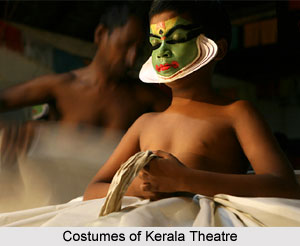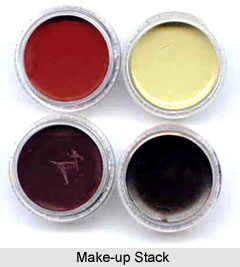 Costumes of Malayalam Theatre are broadly differentiated into various characters. There are actually three types of characters that appear on the stage and they are (1) Minukku (2) Teppu and (3) Tati. The second of these is again of two kinds: (a) Pacca and (b) Haiti, while the third is again of three kinds (a) Kari Karatta Tati, {b) Vella. Tati or Velutta Tati and (c) Cokanna Tati are almost the most important character in almost all plays. The first of these, i.e., Minukku, which literally mean smoothening the face, is the simplest of the kind and consists of a simple powdering of the face with yellow and red pigment and mixed together, adorned here and there with a few white dots. Black ointment is applied to the eyes and the lashes, while the white of the eyes and the lips are reddened by the application of what is called Cundappuvu. The forehead is sometimes adorned with a caste mark of the type called Gopi. This is generally the facial paint for the female sages or saints and holy Brahmins and minor characters. Paced is a slightly more elaborate form of facial paint. The facial front is painted in green, and it is given a white border about an inch in width running all rounds and touching the Cuttinata in the forehead, which forms the base of the headdress. The eyes and lashes and lips are dyed as before. This facial painting is generally given to The Hero or the Nayaka of the play and such other characters as are princes and good men.
Costumes of Malayalam Theatre are broadly differentiated into various characters. There are actually three types of characters that appear on the stage and they are (1) Minukku (2) Teppu and (3) Tati. The second of these is again of two kinds: (a) Pacca and (b) Haiti, while the third is again of three kinds (a) Kari Karatta Tati, {b) Vella. Tati or Velutta Tati and (c) Cokanna Tati are almost the most important character in almost all plays. The first of these, i.e., Minukku, which literally mean smoothening the face, is the simplest of the kind and consists of a simple powdering of the face with yellow and red pigment and mixed together, adorned here and there with a few white dots. Black ointment is applied to the eyes and the lashes, while the white of the eyes and the lips are reddened by the application of what is called Cundappuvu. The forehead is sometimes adorned with a caste mark of the type called Gopi. This is generally the facial paint for the female sages or saints and holy Brahmins and minor characters. Paced is a slightly more elaborate form of facial paint. The facial front is painted in green, and it is given a white border about an inch in width running all rounds and touching the Cuttinata in the forehead, which forms the base of the headdress. The eyes and lashes and lips are dyed as before. This facial painting is generally given to The Hero or the Nayaka of the play and such other characters as are princes and good men.
Katti is a still more elaborate form of facial paint being an improvement on Pacca, in that there is within the bordered Pacca another cutti around the nose, while the space between this and the nose is kept red, the nose being green in colour. The red streak will be over half an inch in thickness and runs up either side of the nose to the forehead and over the brows. In addition to this there will be placed just at the tip of the nose a round ball called Cutti-puvvu which is white in colour. This figure generally presents a fierce character and is very impressive on the stage. This is the costume prescribed for Pratinayaka and those having an Asura tinge in their blood.
Still more elaborate and fierce looking is the costume prescribed for the characters known as Tati. Tati style is of three kinds: (1) Cokanna Tati or the red-beard; (2) Velutta Tati or the white beard and (3) the Kari or Karutta Tati or the black beard. This differentiation is based on the colour of the beard worn by these characters which is an indispensable part of their costume. In this the cutti instead of circling round the nose and spreading out into the forehead runs around the eyes and reaches the Cuttinata, the ends of which together with the central part are adorned by Cuttipuvus. The region of the eyes is painted with dark pigment. The other facial adornments are as before.
Such facial painting helps facial expression considerably, the colours of the paints and projections being devised with specific reference to the various Rasas and Bhavas which predominate the various characters, Kathakali is eminently a play in which the stronger or wilder passions have full play. The exceeding simplicity of the female characters constitutes in itself an evident proof of the minor part they are intended to play in the actual conduct of the play. It is also significant that even the female characters when they have to discharge sterner acts, do appear in a garb more or less worthy of their function. Similarly, when love is depicted, it is always the sensuous and impassioned or the wounded and disappointed type. Thus it is always the strong passions that find expression in Kathakali and the facial expression is such as will suit the strong, sensuous and intensified character of the passion; and naturally with a scientific eye for colour and effect, a variegated scheme has been introduced in facial paints, which agrees perfectly with the facial expression of the Bhavas.
 Quite consistent with the facial paint is the nature of the other items of costumes of which the most important are the head-dress, the breast-plate, the Uttariyam and the skirt. There are two types of headdress which are technically known as Kesabharam kiritam and Muti. The first of these consists of a coronet surmounted by a circular disc; it is generally of two different types - a distinction based mainly on the size of the circular disc. The bigger one is generally used by wicked characters that are ferocious and have some sort of regal splendour, while the smaller kind is used by the other characters.
Quite consistent with the facial paint is the nature of the other items of costumes of which the most important are the head-dress, the breast-plate, the Uttariyam and the skirt. There are two types of headdress which are technically known as Kesabharam kiritam and Muti. The first of these consists of a coronet surmounted by a circular disc; it is generally of two different types - a distinction based mainly on the size of the circular disc. The bigger one is generally used by wicked characters that are ferocious and have some sort of regal splendour, while the smaller kind is used by the other characters.
Both these kinds of headdress are used only by the male characters. The other variety of head-dress, called Muti, which corresponds to the coronet of hair of the sages and saints or the simple crown of kings, is generally worn by characters of a saintly disposition, sages and divine agents or allies, such as Hanuman, Nandikesvara, etc.
The dress for the body is simple, consisting mainly of what is called the Kotalaram, the cover for the breast. It is a movable vest held in position by means of threads. The saintly characters generally have only garlands. Over this vest across the shoulders hang what are called Uttariyams, one of which must be red in colour held in position by means of a Keyuram on the upper arm. There must be besides at least one more Uttariyam of white, but the actual number will depend upon the importance of the character. The forearm is generally adorned with a Katakam and above that are worn some Valas, or bangles. The upper arm will have besides the Keyuram what may be termed a shoulder blade. In case of the female characters, there will not be this shoulder blade or the Uttariyam, while the Kotalaram will have false breasts adorned with garlands made of glass beads, while the waist is generally adorned by an ornate waist belt.
The skirt, worn over drawers, is made of long pieces of cloth white in colour with borders adorned with lace work. The pieces are over a foot in width and are strung closely, the whole being so arranged that while it forms a beautiful skirt, it gives absolute freedom of motion for the legs for acting and dancing. The two sides of the skirt are adorned with embroidered cloth while in front hangs down what is termed a Munti. A leather strap, carrying belts, is tied on both the calf muscles, while at the ankle there is an ornate bandage.
Such, in brief, is the costume that the Kathakali actors use. In devising it, ample consideration is bestowed to suit the costume to the accompaniments and accessories of the stage, which it must be remarked is to a great extent primitive. The heavy costume no doubt make the actors more with slow and measured gait, but it does not preclude the possibility of quick change in pose and position; and it is quite in keeping with the stately dignity of the conception and practice of this variety of our local vernacular entertainment something which is as well echoed in the measured cadence and movement of the highly finished and literary nature of the language.
The costumes worn are quite in keeping with the Hindu ideas of symbolic representation. It may not be quite happy from the realistic point of view, but as symbolising the conception of superior characters and of the free and natural play of Rasas and Bhavas, it can scarcely be said to be second to any. If to reveal the innate quality of the character through costume can be a source of success from the point of view of artistic conception then our dramatists have indeed attained to a high degree of success in this branch of art; for even the most austere critic must perforce admit that the costume of the Kathakali actor does reveal coming to the other accoutrements of the stage, reference deserves to be made only to the musical instruments. These consist of a Cenda, a Cenkila and Elattalam. Cenda, the popular drum, is a wooden cylinder with two ends open and covered up with leather pieces.




